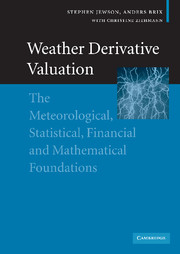 Weather Derivative Valuation
Weather Derivative Valuation Book contents
- Frontmatter
- Contents
- List of figures
- List of tables
- Acknowledgements
- 1 Weather derivatives and the weather derivatives market
- 2 Data cleaning and trends
- 3 The valuation of single contracts using burn analysis
- 4 The valuation of single contracts using index modelling
- 5 Further topics in the valuation of single contracts
- 6 The valuation of single contracts using daily modelling
- 7 Modelling portfolios
- 8 Managing portfolios
- 9 An introduction to meteorological forecasts
- 10 The use of meteorological forecasts in pricing
- 11 Arbitrage pricing models
- 12 Risk management
- 13 Modelling non-temperature data
- A Trend models
- B Parameter estimation
- C Goodness of fit tests
- D Expected pay-offs for normally distributed indices
- E Pay-off variances for normally distributed indices
- F Greeks for normally distributed indices
- G Exact solutions for the kernel density
- H The beta for a normally distributed index
- I Simulation methods
- J Efficient methods for pricing against a portfolio
- References
- Index
C - Goodness of fit tests
Published online by Cambridge University Press: 22 September 2009
- Frontmatter
- Contents
- List of figures
- List of tables
- Acknowledgements
- 1 Weather derivatives and the weather derivatives market
- 2 Data cleaning and trends
- 3 The valuation of single contracts using burn analysis
- 4 The valuation of single contracts using index modelling
- 5 Further topics in the valuation of single contracts
- 6 The valuation of single contracts using daily modelling
- 7 Modelling portfolios
- 8 Managing portfolios
- 9 An introduction to meteorological forecasts
- 10 The use of meteorological forecasts in pricing
- 11 Arbitrage pricing models
- 12 Risk management
- 13 Modelling non-temperature data
- A Trend models
- B Parameter estimation
- C Goodness of fit tests
- D Expected pay-offs for normally distributed indices
- E Pay-off variances for normally distributed indices
- F Greeks for normally distributed indices
- G Exact solutions for the kernel density
- H The beta for a normally distributed index
- I Simulation methods
- J Efficient methods for pricing against a portfolio
- References
- Index
Summary
Goodness of fit tests
In addition to graphical methods one can also perform numerical tests of goodness of fit (GoF). The advantages of such tests are that they are objective (except for chi-square tests – see below) and provide a single number; they can thus be used in automated methods for ranking a number of distributions.
In the following discussion of the most common GoF tests we use the statistical concept of ‘power’ to describe the effciency of the test. A GoF test evaluates how likely it is that the observed sample could have been generated from the distribution in question. The power of the test is the proportion of correctly rejected tests. If a test has low power it means that it is bad at rejecting distributions even if the fit is poor. Conversely, a test with high power is good at identifying distributions that do not match the sample. In practice this means that if a distribution fails a test with low power (such as, for example, chi-square or Kolmogorov–Smirnov (KS)) then this is a good indication that the distribution is not appropriate.
The chi-square test
The chi-square test can be used as a GoF test with any distribution, either continuous or discrete. However, if the distribution is continuous it must first be discretised by dividing the sample space into intervals and binning the observations into these intervals. For a discrete distribution the bins are simply the different outcomes in the sample.
- Type
- Chapter
- Information
- Weather Derivative ValuationThe Meteorological, Statistical, Financial and Mathematical Foundations, pp. 298 - 301Publisher: Cambridge University PressPrint publication year: 2005


